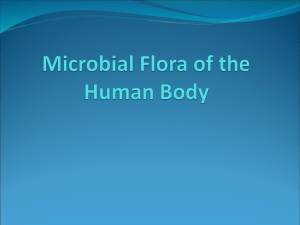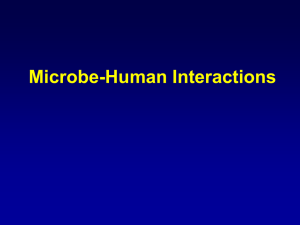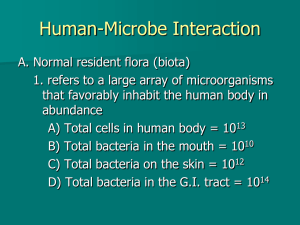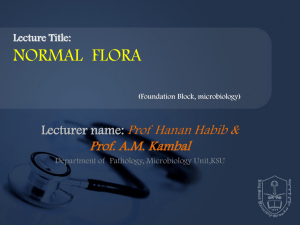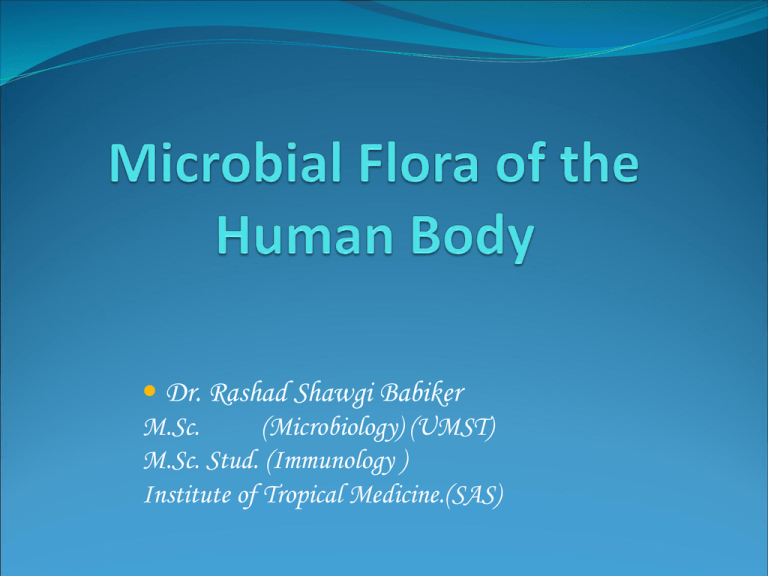
Dr. Rashad Shawgi Babiker
M.Sc.
(Microbiology) (UMST)
M.Sc. Stud. (Immunology )
Institute of Tropical Medicine.(SAS)
Normal Flora
Definition
Normal flora is the
mixture of
microorganisms
(bacteria and fungi) that
are regularly found at
any anatomical site of
human body.
Symbiotic Relationship
1. Mutualistic
Both organisms benefit – “mutually benefical”
2. Commensalistic
One organism benefits, the other is neither helped nor
harmed
3. Opportunistic
Under normal conditions, microbe does not cause
disease, but if conditions become conducive , it can
cause disease
Mutualistic
Escherichia coli
Synthesizes Vitamin K & B complex Vitamins
In return, we provide a warm, moist nutrient rich
environment for E. coli
Commensalistic
We have no Commensalistic relationships with Bacteria
If Bacteria are in or on our body, they are either helping
us (Microbial Antagonism) or harming us.
Opportunistic
Escherichia coli - normally in our digestive tract where
it causes no problems, but if it gets into the urinary
tract it can become pathogenic.
Staphylococcus aureus – commonly found in the upper
respiratory tract, but if it gets into a wound or a burn it
can become pathogenic
The Three Types of Symbiotic
Relationships
Table 14.1
Normal Microbial Flora
1. Resident Flora
Microbes that are always present
2. Transient Flora
Microbes that live in or on your body for a period of time
(hours, days, weeks, months) then move on or die off
Transient Microbiota
Remain in the body for only hours to
months before disappearing
Found in the same regions as resident
microbiota
Cannot persist in the body…because…
Competition from other microorganisms
Elimination by the body’s defenses cells
Chemical or physical changes in the body
Normal Flora
Sterile tissues
In a healthy human, the
internal tissues such as:
blood
brain
muscle
cerbrospinal fluid (csf.)
are normally free of
microorganisms.
Normal Flora
Skin
Eyes (i.e.Cunjunctiva)
Nose (i.e. Respiratory
tract)
Mouth (i.e Human Oral
Cavity)
Ears
Urogenetal tract
Elementry tract
Normal Flora
Resident flora
Acquired rapidly during
& after birth
Normal Flora
Resident flora
Reflects age of person
Normal Flora
Resident flora
Changes continuously through
out life .
Normal Flora
Resident flora
Reflects nutrition of
person
Normal Flora
Resident flora
Reflects genetics of
person
Normal Flora
Resident flora
Reflects environment of
person
Normal Flora
Resident flora
Reflects sex of
person
Importance of The
Normal Flora
(Advantages)
1. They constitute a
protective host
defense mechanism
by occupying
ecological niches.
(Advantages)
2. They produce vitamin B
and vitamin K in
intestine.
Importance of The Normal Flora
(Advantages)
3. The oral flora
contribute to
immunity by inducing
low levels of
circulating and
secretory antibodies
that may cross react
with pathogens.
Importance of The Normal Flora
(Advantages)
4. The oral bacteria flora
exert microbial
antagonism against
nonindigenous species
by production of
inhibitory fatty acids,
peroxides, bacteriocins,
etc.
Importance of The Normal Flora
(Advantages)
5. The normal flora may
antagonize other
bacteria through the
production of
substances which inhibit
or kill nonindigenous
species.
Importance of The Normal Flora
(Disadvantages)
1. They can cause disease in
the following:
a) When individuals
become
immunocompromised.
b) When they change their
usual anatomic location.
Importance of The Normal Flora
2. The oral flora of humans
may harm their host since
some of these bacteria are
pathogens or opportunistic
pathogens
Contamination vs. Infection
Contamination – the mere presence of microbes in or on
the body
Infection – results when the organism has evaded the
body’s external defenses, multiplied, and become
established in the body
Portals of Entry
Sites through which pathogens enter the body
Four major types
Skin
Mucous membranes
Placenta
Parenteral route
Skin
Outer layer of packed, dead, skin cells
usually acts as a barrier to pathogens
Some pathogens can enter through
openings or cuts
Others enter by burrowing into or
digesting the outer layers of skin…flesh-
eating bacteria
Mucous Membranes
Line the body cavities that are open to
the environment
Provides a moist, warm environment
that is hospitable to pathogens
Respiratory tract is the most commonly
used site of entry – entry is through the
nose, mouth or eyes
Pathogens able to survive the acidic pH
of the stomach may use the
gastrointestinal tract as a route of entry
Some Pathogens that Cross the
Placenta
Table 14.3
Parenteral Route
Pathogens deposited directly into tissues beneath the
skin or mucous membranes
Infection vs. Disease
Infection is the invasion of the host by a pathogen
Disease results only if the invading pathogen alters the
normal functions of the body
Disease is also referred to as morbidity
Manifestations of Disease
Symptoms – subjective characteristics of disease felt
only by the patient
Signs – objective manifestations of disease that can be
observed or measured by others
Syndrome – group of symptoms and signs that
characterize a disease or abnormal condition
Asymptomatic, or subclinical, infections lack
symptoms but may still have signs of infection
Etiology
Study of the cause of disease
Germ theory of disease – disease caused by infections of
pathogenic microorganisms
Robert Koch developed a set of postulates one must
satisfy to prove a particular pathogen causes a particular
disease
Koch’s Postulates
Figure 14.7

